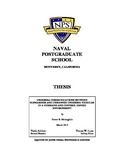Investigation of the sensitivity of a patrolling submarine's capability to gain a detection as a function of increasing surface ship speeds
| dc.contributor.advisor | Cunningham, Peyton W. | |
| dc.contributor.advisor | Pollock, Stephen M. | |
| dc.contributor.author | Cyr, Joseph Henry | |
| dc.contributor.author | Santos, Leonard Bento | |
| dc.date | October 1969 | |
| dc.date.accessioned | 2012-08-29T23:32:47Z | |
| dc.date.available | 2012-08-29T23:32:47Z | |
| dc.date.issued | 1969 | |
| dc.identifier.uri | https://hdl.handle.net/10945/12479 | |
| dc.description.abstract | Numerical integration and Monte Carlo techniques are used in the development of several models in order to determine the effect on probability of random detection of a merchant ship using speeds up to 90 knots by a 10 knot submarine patrolling a back-and-forth barrier. A definite range law for detection is assumed. Individual encounter models are developed for ship tracks which cross the midpoint of the submarine patrol line at various angles. The models are extended to include the assumption of a normal-distribution of crossing points. Computer programs of the models, written in the FORTRAN IV language, are included. The results are applied in a numerical example. It is concluded that while increases in ship speeds do result in a substantial decrease in probability of detection by a submarine in the case of a single barrier transit, a speed advantage alone when applied to a typical transit of the North Atlantic will not appreciably decrease the overall detection probability. | en_US |
| dc.description.uri | http://archive.org/details/investigationofs1094512479 | |
| dc.language.iso | en_US | |
| dc.publisher | U.S. Naval Postgraduate School | en_US |
| dc.rights | This publication is a work of the U.S. Government as defined in Title 17, United States Code, Section 101. Copyright protection is not available for this work in the United States. | en_US |
| dc.title | Investigation of the sensitivity of a patrolling submarine's capability to gain a detection as a function of increasing surface ship speeds | en_US |
| dc.type | Thesis | en_US |
| dc.contributor.corporate | Naval Postgraduate School | |
| dc.contributor.department | Department of Operations Analysis | |
| dc.description.service | Lieutenant Commander, United States Navy | en_US |
| etd.thesisdegree.name | M.S. in Operations Research | en_US |
| etd.thesisdegree.level | Masters | en_US |
| etd.thesisdegree.discipline | Operations Research | en_US |
| etd.thesisdegree.grantor | Naval Postgraduate School | en_US |
| dc.description.distributionstatement | Approved for public release; distribution is unlimited. |
Files in this item
This item appears in the following Collection(s)
-
1. Thesis and Dissertation Collection, all items
Publicly releasable NPS Theses, Dissertations, MBA Professional Reports, Joint Applied Projects, Systems Engineering Project Reports and other NPS degree-earning written works.





